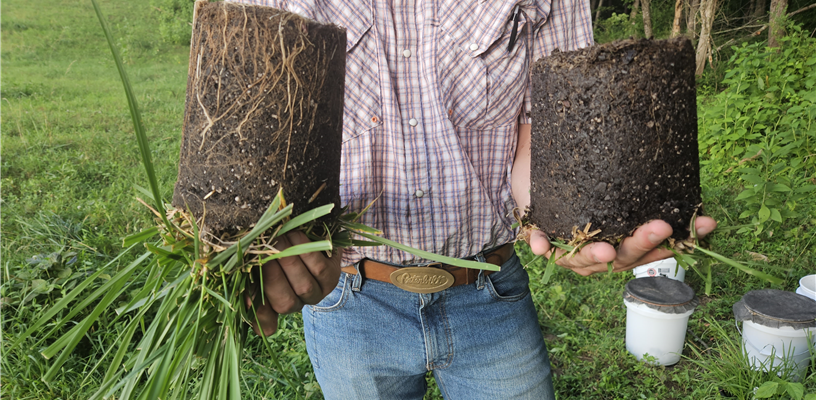
- By April W Bowman
- Posted Monday, February 19, 2024
Re.... a Field or Pasture: Replant, Rejuvenate, or Renovate
Growing grass isn't as simple as one might think. The first step is to do a soil test. We have free soil test kits available 24/7 at our office in the information sign at the Demonstration Garden. NC Department of Agriculture and Consumer Services (NCDA&CS) provides free soil testing from April through November and charges $4 per sample from December through March. NCDA&CS does request that you complete a form online, print it, and include it with your sample if possible instead of including a handwritten copy. Learn more at https://forsyth.ces.ncsu.edu/2023/12/soil-test-kits/. Soil pH and fertility can have a great impact on our weeds - they typically grow in less ideal conditions than our desirable forages. Many of the pastures and hayfields in the Piedmont of North Carolina contain fescue. We typically recommend 30-50 pounds of Nitrogen per acre in early spring to get those grasses jump-started and growing as the weather warms up. However, if your field is more weeds than grasses, I would wait on this until you can get some control. We don't want to encourage weed growth.
Weed Control February is the ideal time to control those pesky yellow flowers from Buttercup with 2,4-D (NOT April when you see the flowers). Click here for more information on controlling buttercups. You can access our favorite Weed Control Hand-out for Grass Fields at https://www2.ca.uky.edu/agcomm/pubs/agr/agr172/agr172.pdf. This is produced by the University of Kentucky, but the information is valid.
Planting We can also out-compete our weeds with desirable forages. Forsyth County Soil and Water Conservation has a No-till drill available for rent. Contact Mike Bowman at bowmanml@forsyth.cc or by phone at 336-703-2840 to reserve your space. It is recommended that you have a tractor with at least 40 hp and the drill does require rear hydraulic attachments. The current rental fee is $12 per acre. If you are going to be planting, ensure that you are planting at the ideal time. Probably the number one requirement for planting is moisture. The second is temperature. Visit the N.C. Forage Planting Guide to determine the best planting dates for your region at https://content.ces.ncsu.edu/planting-guide-for-forage-crops-in-north-carolina. February 20 - March 20 is the best time to plant cool-season annuals like oats, ryegrass, and brassicas such as turnips and perennials like Fescue in the Piedmont of North Carolina. Warm-season forages like pearl millet, sorghum, and teff can be planted April 25-June 30. There is a shortage of many forage seeds due to the drought in the Midwest, so secure your seeds early.
Avoid over-grazing your pastures; leave at least 4" of growth after grazing. Move animals to a new pasture section, or drylot them and provide hay while that pasture rests. Bare ground is an ideal place for weeds to pop up. While you are looking at the height of your forages, take the time to do a step-point check, stopping every 20 steps to see what a specific point on your boot is pointing at. Is it a desirable forage, or an undesirable weed? Learn more from the Alliance for Grassland Renewal here.
Pasture Establishment/Renovation If you don't have an existing "pasture" per se, but have more of an overgrown field, can you afford to make your field a pasture? The University of Missouri has the most recent prices that we can find for pasture establishment. To begin the renovation process, ask yourself the following questions:
- Is there woody vegetation? Are there trees greater than two inches in diameter?
- What are the present soils? Are there wet or dry sections?
- How rough is the site? Are there rocks or severe ruts that would obstruct tractor and equipment moving through the field?
- How quickly do you want the field put back into production? One to two years? Three to four years?
- What equipment is available?
- What will be the eventual use of the field — pasture, exercise lot, hayfield, crop production, or an area with scenic value?
- What is the slope of the field? What is at the bottom of that slope?
If you have time, and the field is smooth enough for your purposes, regular mowing (three times per season) plus appropriate fertilizer and lime additions will produce a good field in three to four years. Regular mowing will help improve the species composition and allow various clover species to come back into the field. At this point, if you are trying to re-claim the field, haven't planted any new forages, and don't have animals grazing it, I would mow it fairly short when mowing, to try to prevent weed growth. If you want to introduce desirable species into the field, think about frost-seeding clover and no-till seeding when the time is right and immediately after mowing. After this point, I would begin mowing the forages as high as you can set the bush hog or mower. The more forage you can leave on top of the plant, the more shade and shelter the roots will have and the better established those plants will get. Continue to monitor your weed pressure and if you see undesirable plants going to see, then it's time to mow.
Finally, if you are interested in purchasing livestock to graze on your field that you are converting to a pasture, but aren't sure what you want to raise, see this hand-out from the Center for Environmental Farming Systems on the different livestock enterprises. Put up the fence for the animals that you may raise in the future versus what you are starting with; it will be less expensive in the long run. Remember that we are keeping predators out in addition to keeping livestock in. The University of TN has a fencing resource that I like. If you are in Forsyth County and would like a printed copy, please let me know. Inadequate grounding of electric fences is one of the most common mistakes we see. Virginia Tech has a really good resource on how to ground an electric fence.
For more information, email, April Bowman, Extension Agent, Livestock, Forages, and 4-H Youth Development at awbowman@ncsu.edu or call 336-703-2855.






